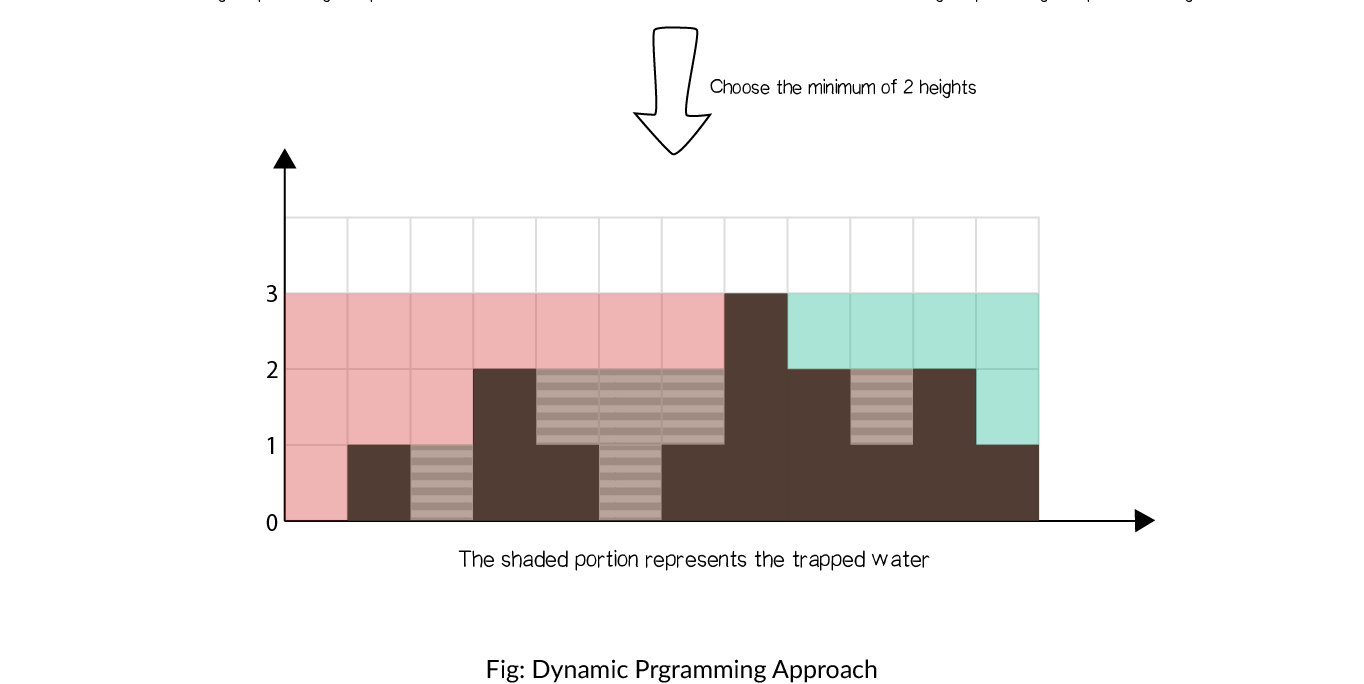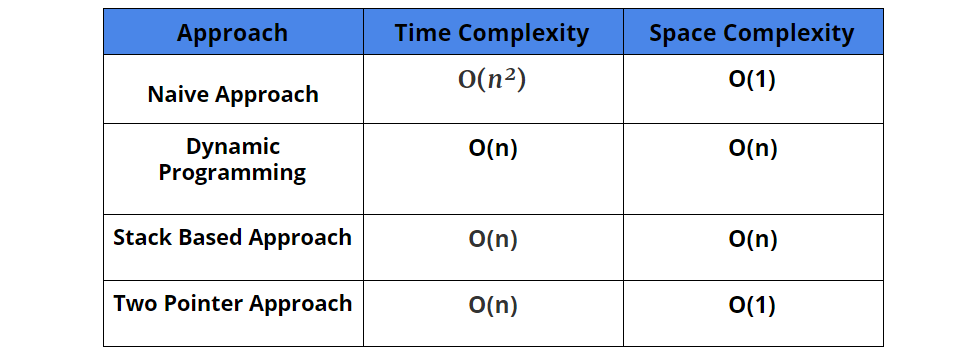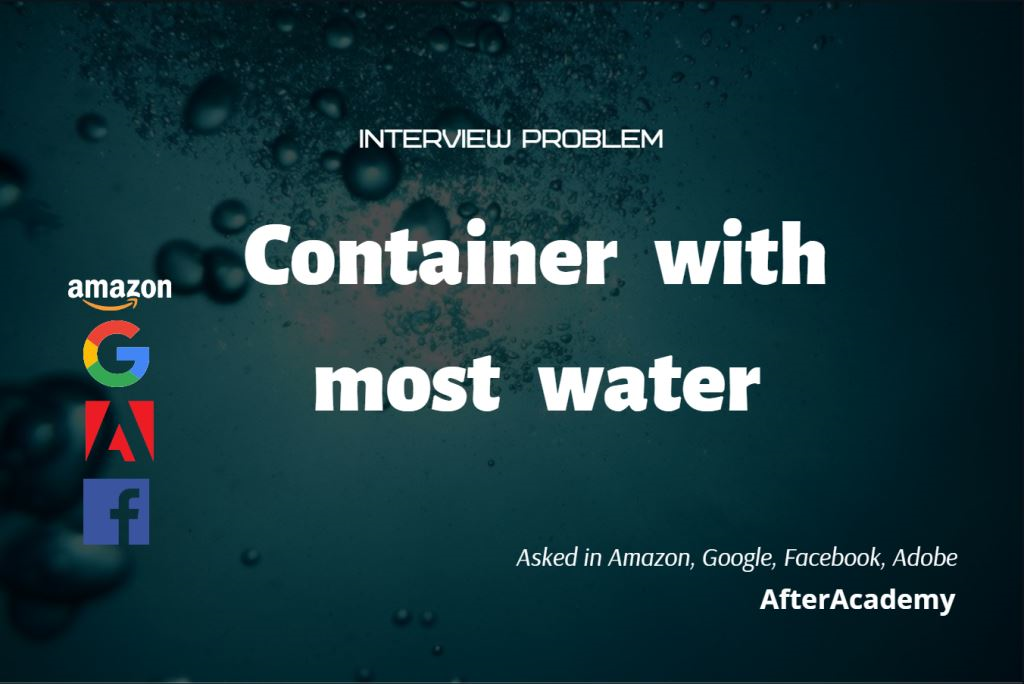Rain Water Trapping

Difficulty: Hard
Asked in: Amazon, Google
Understanding the problem
Problem Description: Given n non-negative integers representing an elevation map where the width of each bar is 1.
Write a program to compute how much water it is able to trap after raining.

The above elevation map is represented by array [1,0,2,1,0,1,3,2,1,2,1]. In this case, 6 units of rain water (blue section) are being trapped.
Example
Input: [0,1,0,2,1,0,1,3,2,1,2,1]
Output: 6Before proceeding, you may try to solve this problem here .
Solutions
- Naive Approach — Add the trapped water for each index by examining every other possible index.
- Dynamic Programming — Use two arrays to store max heights from left and right.
- Stack Based Approach — Use a stack to keep track of the bars that are bounded by longer bars
- Two Pointer Approach — Take two pointers to keep track of the height of bars that could store water.
1. Naive Approach
For each element in the array, we find the maximum level of water it can trap after the rain, which is equal to the minimum of the maximum height of bars on both the sides minus its own height.
Solution steps
- Take a variable maxWater to store maximum water and initialize it with 0
- For every index of the array, do the following
-
Find the highest bar on its left and store it in
leftHeight -
Find the highest bar on its right and store it in
rightHeight -
Update
maxWaterwithmaxWater + min(leftHeight, rightHeight)-arr[i]
3. Return
maxWater
Pseudo Code
int maxWaterTrapped(int[] height, int size) {
int maxWater = 0
for (int i = 1 to size-1) {
int leftHeight = height[i]
for (int j = 0 to i)
leftHeight = max(leftHeight, height[j])
int rightHeight = height[i]
for (int j = i+1 to size)
rightHeight = max(rightHeight, height[j])
// Update the maximum water
maxWater = maxWater + (min(leftHeight, rightHeight) - height[i])
}
return maxWater
}Complexity analysis
Time complexity: O ( n² ).
Space complexity : O (1).
Critical Ideas to Think
- How did we find out the amount of water trapped inside every pair of bars?
- What do leftHeight and rightHeight represent?
2. Dynamic Programming
In brute force, we iterate over the left and right parts again and again just to find the highest bar size up to that index. But, this could be stored, i.e. dynamic programming.
The concept is illustrated as shown:


Solution steps
-
Find the maximum height of the bar from the left end up to an index i in the array
left_max. -
Find the maximum height of the bar from the right end up to an index i in the array
right_max. -
Iterate over the
heightarray and updatemaxWater as→
Add
min(max_left[
i
], max_right[
i
]) − height[
i
]
to ans
wer
Pseudo Code
int maxWaterTrapped(int[] height, int size) {
int maxWater = 0
int left_max[size], right_max[size]
left_max[0] = height[0]
for (int i = 1 to size) {
left_max[i] = max(height[i], left_max[i - 1])
}
right_max[size - 1] = height[size - 1]
for (int i = size - 2; i >= 0; i--) {
right_max[i] = max(height[i], right_max[i + 1])
}
for (int i = 1 to size-1) {
maxWater += min(left_max[i], right_max[i]) - height[i]
}
return maxWater
}Complexity analysis
Time complexity: O ( n ).
Space complexity: O ( n ).
Critical Ideas to Think
- Why do you think that storing the max bars up to each index from start and end helps?
- How did we optimize approach 1 with this approach?
3. Stack Based Approach
Instead of storing the largest bar up to an index, we can use a stack to keep track of the bars that are bounded by longer bars and hence, may store water. Using the stack, we can do the calculations in only one iteration.
We keep a stack and iterate over the array. We add the index of the bar to the stack if the bar is smaller than or equal to the bar at top of the stack, which means that the current bar is bounded by the previous bar in the stack. If we found a bar longer than that at the top, we are sure that the bar at the top of the stack is bounded by the current bar and a previous bar in the stack, hence, we can pop it and add resulting trapped water to
maxWater
.
Solution steps
- Use stack to store the indices of the bars.
- For each bar of the array do the following
-
While stack is not empty and
height[ current ]>height[ st . top ()] -
It means that the stack element can be popped. Pop the top element as
top. -
Find the distance between the current element and the element at top of stack, which is to be filled.
distance=current−st.top()−1 -
Find the bounded height
bounded_height=min(height[current],height[st.top()])−height[top] -
Add resulting trapped water to answer
ans+=distance × bounded_height - Push current index to top of the stack
- Move current to the next position
Pseudo Code
int maxWaterTrapped(int[] height, int size)
{
int maxWater = 0, current = 0
stack st
while (current < size) {
while (not st.empty() and height[current] > height[st.top()]) {
int top = st.top()
st.pop()
if (st.empty())
break
int distance = current - st.top() - 1
int bounded_height = min(height[current], height[st.top()]) - height[top]
maxWater += distance * bounded_height
}
st.push(current)
current = current + 1
}
return maxWater
}Complexity analysis
Time complexity: O ( n )
Space complexity: O ( n )
Critical Ideas to Think
- What we stored in the stack?
- How does storing the larger bars in stack helped in solving the problem?
- Can you dry run the above algorithm for the above test case?
4. Two Pointer Approach
We have
leftMax
and
rightMax
that record the largest heights
lo
and
hi
have seen so far.
As in DP approach, instead of computing each
leftMax
and
rightMax
separately, we can actually consider one bar at each time as our
min(leftMax, rightMax)
since we only care about the bar with a smaller height.
We denote two pointers
lo
and
hi
starting from two ends of the array. In the loop, we update
leftMax
and
rightMax
first.
If the current
leftMax
is less than
rightMax
, we can correctly compute the water at
lo
, but not the water at
hi
.
Let’s examine the case
leftMax < rightMax
. We assume a
leftMax
in
height[0, lo]
. Since we do the update first,
height[lo]
should be less than or equal to
leftMax
(it means that
leftMax
could have been just updated by
height[lo]
).
Since
leftMax < rightMax
, the amount of water at
lo
can be determined at this time, no matter what the heights between
[lo + 1, hi - 1]
are.
Solution steps
-
Initialize
lopointer to 0 andhipointer to size-1 -
Do the below steps until
left<right
-
update
leftMaxandrightMaxwithmax(leftMax, height[lo]) and max(rightMax, height[hi]) -
update
wateraccording to leftMax and rightMax
Pseudo Code
int maxWaterTrapped(int[] height, int size) {
int lo = 0, hi = size - 1
int leftMax = 0, rightMax = 0
int water = 0
while (lo < hi) {
// update
if (height[lo] > leftMax)
leftMax = height[lo]
if (height[hi] > rightMax)
rightMax = height[hi]
// compute
if (leftMax < rightMax) {
// consider the min
water += (leftMax - height[lo])
lo = lo + 1
} else {
water += (rightMax - height[hi])
hi = hi - 1
}
}
return water
}Complexity analysis
Time complexity: O ( n )
Space complexity: O (1)
Critical Ideas to Think
- How are we updating these two pointers?
- Why do you feel this algorithm should work?
- Why did we update one of the two pointers only when it came across the smaller bar?
Comparison of solutions

Suggested problems to Solve
- Container with most water
- Product of array except for itself
- Pour water
- Smallest subarray with an equal number of odd and even elements
If you have any more approaches or you find an error/bug in the above solutions, please comment down below.
Happy Coding! Enjoy Algorithms!
